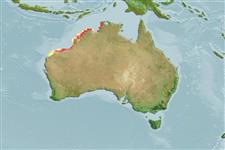>
Ophidiiformes (Cusk eels) >
Dinematichthyidae (Viviparous brotula)
Etymology: Beaglichthys: Related to the Darwin´s ship Beagle + Greek, ichthys = fish (Ref. 45335); bleekeri: Named for Pieter Bleeker..
More on authors: Schwarzhans & Møller.
Environment: milieu / climate zone / depth range / distribution range
экология
морской демерсальный; пределы глубины 0 - 5 m (Ref. 90102). Tropical; 12°S - 22°S, 110°E - 135°E (Ref. 76869)
распространение
страны | регионы FAO | Ecosystems | места находок | Point map | интродукции | Faunafri
Eastern Indian Ocean: Indonesia and Australia.
Size / Вес / Возраст
Maturity: Lm ? range ? - ? cm
Max length : 7.2 cm SL самец/пол неопределен; (Ref. 76869)
Краткое описание
определительные ключи | морфология | морфометрия
членистые (мягкие) лучи спинного плавника (общее число) : 84 - 86; членистые (мягкие) лучи анального плавника: 63 - 68; позвонки: 44 - 45.
Collected from tidepools (Ref. 76869). Cryptic in shallow water (usually <5 m) (Ref 90102).
Life cycle and mating behavior
Maturities | размножение | Spawnings | Egg(s) | Fecundities | личинки
Schwarzhans, W. and P.R. Møller, 2007. Review of the Dinematichthyini (Teleostei: Bythitidae) of the Indo-west Pacific. Part III. Beaglichthys, Brosmolus, Monothrix and eight new genera with description of 20 new species. The Beagle, Records of the Museums and Art Galleries of the Northern Territory 23:29-110. (Ref. 76869)
Статус Красного Списка МСОП (Ref. 130435)
Угроза для людей
Harmless
Использование человеком
рыболовство: интереса не представляет
дополнительная информация
инструменты
Специальные отчеты
Скачать в формате XML
ресурсы в Интернет
Estimates based on models
Preferred temperature (Ref.
123201): 26.4 - 28.7, mean 28.2 °C (based on 56 cells).
Phylogenetic diversity index (Ref.
82804): PD
50 = 0.6250 [Uniqueness, from 0.5 = low to 2.0 = high].
Bayesian length-weight: a=0.00389 (0.00180 - 0.00842), b=3.12 (2.94 - 3.30), in cm total length, based on all LWR estimates for this body shape (Ref.
93245).
Trophic level (Ref.
69278): 3.3 ±0.5 se; based on size and trophs of closest relatives
Fishing Vulnerability (Ref.
59153): Low vulnerability (10 of 100).
